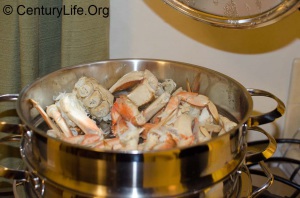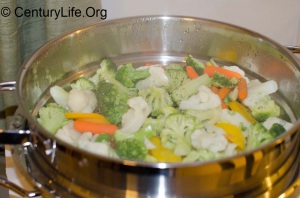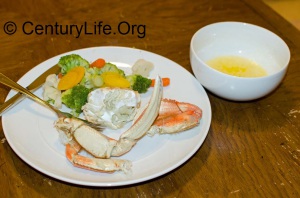STEAMING
By steam, I mean boiling water to generate water vapor that cooks your food at 212F/100C (at sea level). You could also use pressure cookers, especially if you live at high altitudes such that boiling water isn’t as hot.
A. Pros and Cons
Pros:
Steaming is easy and time-efficient, and it’s healthier than boiling food, since boiling water tends to leach out a lot more nutrients than the small amount of water that condenses onto steamed food.
Steaming is also versatile. I’ve steamed pork chops, sausages, chicken thighs, spinach, kale, metballs, salmon fillets, crabs, lobsters, frozen vegetables, scallops, and more.
Furthermore, if you have a cooktop with a timer, you can literally set-and-forget and then come back once you’re done with whatever it was that took you outside of the kitchen. When the timer goes off, it’s time to eat. Even without a built-in timer, you can buy a cheap timer with audio alarm to tell you when to turn off the cooktop. We use the Polder 898-95 Clock, Timer and Stopwatch, which has a handy string AND magnet on the back. It also serves as a count-down alarm clock for naps, a laundry alarm and a clock. We slap it on the side of the fridge when it’s not in use. You can also get it in white
if it better matches your kitchen decor.
You can cook rice or pasta in the pot and steam things up in the steamer basket on top and let the drippings come down to the rice or pasta for extra flavor. Highly energy efficient! This also works with stacked steamers.
If you have multiple types of food that take different times to cook, the easiest thing to do is to use multiple steamer baskets. For instance if group A takes 20 minutes to steam, and group B takes 5 minutes to steam, you can steam group A in one basket for 15 minutes, and then add group B in another steam basket, and steam both at the same time for 5 more minutes (20 minutes total). If you don’t have multiple baskets, then you will have to manually add Group B into the same steamer basket as Group A, after 15 minutes. And Group B would have to be the top layer. That’s not a problem if you actually want it to be the top layer, but it’s not ideal if Group A would be better as the top layer.
Cons:
Steamed food tends to be bland unless pre-spiced. For instance, steamed fish isn’t particularly tasty. But add a little salt, pepper, and lime juice after steaming, and you can turn even bland, steamed salmon into a reasonably tasty alternative to sauteed salmon. Furthermore, you can stack food so that tastier food will drip juices down into blander food.
B. Equipment
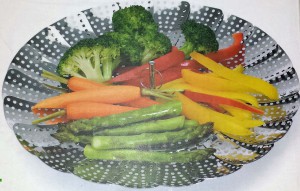
In order to steam, you need a pot and a steamer device of some sort, or else a pot with a tight, heavy lid so that you turn the pot into a pseudo pressure cooker (so-called waterless cooking). My personal favorite is a metal steamer basket that sits on top of stockpots. They are sturdy and relatively easy to clean. They don’t fall apart like the stick-and-leaves steamers (the kind with a long metal stem and metal foils that spread out from the stem like flower petals; see picture to the left). They have higher clearance than silicone steamers, so you don’t have to be as careful to keep water levels low. They avoid the cracking and mold issues of bamboo. And unlike cooling racks with big gaps (the kind you’d use for cooling cookie trays), the holes are small enough so that you aren’t very limited in terms of what you can steam. Plus cooling racks tend to be made with chrome-plated steel, so they start rusting once any of that chrome chips off.
Regarding metal steamer baskets, I would get the widest steamer basket you can find that is still compatible with your saute pan or stock pot, preferably a basket with lots of holes punched out on both the bottom and sides of the steamer basket. Why wide, and why so holey?
- Wide and holey baskets allow more ways for steam to penetrate the basket. I used to have a cheap steamer basket that was small diameter and had only a few holes punched in the bottom. Frozen peas (or corn, etc.) would often melt and clog up the few steam holes, leading to uneven cooking where the bottom layer of food was overcooked, while the top layer was undercooked.
- Wide baskets allow easier placement of long foods such as uncut asparagus spears.
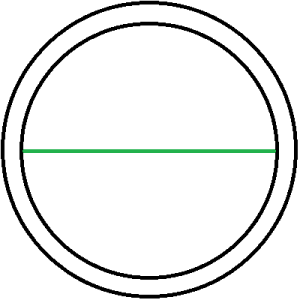
In order to have maximum compatibility, try to get a 20 cm, 24 cm, or 28 cm steamer basket if at all possible. Those are the standard sizes that Europe and Asia use, and most cookware is made in Europe or Asia. If you get some weird size like 25 cm, you probably won’t be able to use it on anything other than the very specific, 25 cm diameter pot that it was designed for.
Note that the way to take the diameter of a pot or pan is to measure the distance from the interior wall to the opposite interior wall. Most manufacturers follow this convention, and it makes sense–any lid designed for a 24cm interior-diameter pot will work with any 24cm interior-diameter pot. The thickness of the pot or any curvature related to flared rims is irrelevant. Unfortunately, a few companies exaggerate the size of their equipment by measuring the outer-to-outer diameter instead, including any curvature in the lip of the pan, in order to make the pan sound bigger than it really is.
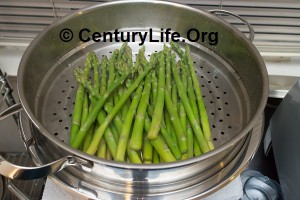
Other considerations: I would favor rivetless designs over riveted designs, as food particles can get stuck around rivets. I would also favor designs that have less-acute ridges (the part that juts out of the sides of the steamer basket, which rests on the lip of your stockpot), as food particles can get stuck on the ridge as well. Lastly, steamer baskets work well as colanders for quickly rinsing vegetables and fruits. Colanders do not work as well as steamer baskets because they weren’t designed for heavy usage in mind, nor do they have handles, and many stainless colanders are made with cheaper, more rust-prone grades of stainless steel; furthermore if you try to use them as steamer baskets inside pots, the colander lip interferes, so the lid can’t seal the top.
NOTE: Pressure cookers are great for cooking lots of food for a long time, such as simmering beans in under an hour, but in my opinion they are a) harder to steam in because you have to use little baskets and trivets, b) harder to clean (and produce unnecessary wear and tear on your pressure cooker), and c) overkill for typical 15-minute dinner steams. I also do not recommend so-called waterless cooking, which basically means using cookware with a thick, heavy lid and adding a little bit of water which you hope will be exactly enough to get the job done. That means you have far less margin for error compared to using steamer baskets.
If you want specific recommendations on steamer baskets, here they are:
Low budget: If you want the bare minimum size I’d consider (2 quart capacity) and could use a small, three-quart disc-bottom stockpot anyway, get the Farberware 70043 Classic Stainless Steel 3-Quart Stack ‘N Steam Saucepot and Steamer.
16/18/20 cm (6.3/7.1/8 inch): If you have an existing pot of these diameters, and don’t want more than three quarts of steaming capacity, you can get an universal steamer. I’d recommend this Cooks Standard Stainless-Steel Universal Steamer Insert with Lid, which is not multi-layered, despite the product description, since it’s unnecessary (steam spreads heat very evenly even with thin stainless steel sidewalls). It fits 16, 18, and 20 cm pots and holds about 3 quarts.
Alternatively, get this Cuisinart 7116-20 Chef’s Classic 20-Centimeter Universal Steamer with Cover which also has a stainless lid. If you would prefer a glass lid, get the Circulon 70135 Stainless Steel Universal Steamer
. If it must be rivetless, and you have an 20cm/8-inch pot, then get the Scanpan 8-inch Steamer Insert which is made in China. Please note that these smaller steamer baskets are sub-optimal options because they a) have lower steamer hole density than larger-diameter steamers so that you may have to steam longer and hotter to reach the top layer of food, and b) three quarts is not a lot of food for more than two or three people. In my household, we almost always use the larger-diameter (24cm) steamers because we like leftovers.
Highest-end 24 cm (9.45 inch): The Cadillac combo at 24 cm is the Demeyere Atlantis 41324 5.5 Quart Casserole with Lid with matching Demeyere Atlantis 45724 5.5 Quart Stackable Steamer
. The Demeyere steamer basket is the best one I’ve ever used. It’s easy to clean, with no rivets and no deep divot/ridge for food to hide in. It even comes with a rubber sealing ring, though that’s probably overkill; in my experience, rubber sealing rings are unnecessary unless you are stacking more than two steamers on top of each other. Almost all USA/European-made steamer baskets are very high priced compared to Chinese steamer baskets, and many of them aren’t even better made than their Chinese counterparts. At least the Demeyere is better-made.
Midrange 24 cm (9.45 inch) with existing stock pot: If you already have a 9.5 inch (24 cm) pot and just want a steamer basket or pasta insert, here are some decent choices:
KitchenAid KCH280PIST Pasta and Steamer Insert for 24 cm diameter pots This is a steamer and pasta insert combo for existing ~8 quart stock pots of 24 cm (~9.5 inch) diameter. It’s not dirt cheap, but at least you know you are getting a quality product, unlike steamer baskets that claim to be stainless but rust. The steamer insert rests inside of the pasta insert, which rests inside of your stock pot. Make sure your stock pot is 8 quarts or more, else the pasta insert probably will not fit.
If you just want a steamer basket with external handles, it will cost you practically the same amount of money anyway: Tramontina 80101/018DS Gourmet Prima Steamer Insert and KitchenAid KCH180SIST Steamer Insert, 8-Quart
.
Please note that pasta inserts are not as indispensable as steamer inserts. I don’t use pasta inserts anymore because they a) waste water (often sitting 1.5+ inches above the floor of the pot); and b) are large and take extra time to hand-wash (or take up a lot of space in a dishwasher). Instead, I use a lid-sieve (Kuchenprofi 0808212800 24 cm 18/10 Stainless Steel Strainer Sieve) which is easier to clean. Avoid one-handed strainers
, which can be hard to use with heavier pots; I’ve lost more than one dinner down the drain before with one-handed strainers. Two-handed strainers are more stable to hold and can be used to do things like strain stock. I’d also avoid plastic strainers, because hot water degrades plastic, causing the plastic to emit harmful chemicals into your food.
Midrange 24 cm (9.45 inch) options if you also need a stock pot or pressure cooker:
If you could use a pressure cooker anyway, try the Fagor 918060787 8-Quart Stainless-Steel Pressure Cooker with Steamer Basket which comes with a steamer basket. I have this pressure cooker, though I mainly use it as a pressure cooker and not as a steamer, since I already have a ton of dedicated steamer baskets that allow me to use regular stock pots. I figure that I shouldn’t subject the pressure cooker to unnecessary wear and tear.
If you want a regular stock pot instead of a pressure cooker, then the cheapest decent option (albeit with dubious-quality stainless steel) is the Cook N Home 02401 Stainless Steel 4-Piece Pasta Cooker Steamer Multipots with Encapsulated Bottom, 8-Quart. If you can spare $10 more, you can instead get the Tramontina 18/10 Stainless Steel 4-Piece 8-Quart Multi-Cooker Set
which is made by a more reputable manufacturer. Alternatively, consider the Calphalon VMP8P Pantryware 8 Qt. Multi Pot
. Both are a good size for up to a family of four, have both a pasta and steamer insert, are induction-compatible, and have thick aluminum disc bases. The Calphalon has rolled rims for less dripping while pouring. The downside is how they both have a less-durable glass instead of steel lid and how you may have to find a towel or oven mitt when it’s time to retrieve the handles of the steamer Calphalon’s basket.
Whatever you do, do NOT get a steamer basket that has a band of metal as an interior handle. Either get a steamer basket that has handles sticking out the sides, or one with an interior wire handle. If it has an interior band of metal, that band will etch a circular pattern into the interior sides of the steamer basket over time. Stick with steamer baskets that have interior wire handles, or exterior handles that stick out the sides. Here is an example of the “band of metal handle” design that you do NOT want to get.
Please note that pasta inserts are not as indispensable as steamer inserts. You can use a colander instead, or even strain pasta through a steamer basket. Personally I don’t use pasta inserts anymore because they are large and take extra time to hand-wash (though they can be dishwashered just fine). Instead, I use a strainer like this Kuchenprofi 24 cm Strainer Sieve in 18/10 Stainless Steel which is easier to clean. There are cheaper ones out there that are one-handed, but there is a greater risk of slippage. The two-handed strainers are more stable to hold and can even be used to do things like strain stock.
Medium budget ~26cm (10.25 inch): If you don’t mind the lack of induction compatibility (but better corrosion resistance on the bottom because of it), and somewhat proprietary size, you can get an all-in-one pot with steamer AND pasta insert for relatively cheap: the Cuisinart 77-412 Chef’s Classic Stainless 4-Piece 12-Quart Pasta/Steamer Set. You could literally steam meatballs and have drippings go into the pasta below, as one example. If you need more than a couple of quarts of steaming capacity, you can use the pasta insert as a giant steamer though you run the risk of boiling water reaching the bottom of the basket, so fill the pot carefully. It’s also a bit tall, so make sure you have at least ~15 inches of clearance from stovetop to overhead obstruction (e.g., range hood) so you can get your hand on the lid handle. I used to have this pot and would have kept it if it were induction-compatible.
If you want just the 26cm steamer insert, get this Danish-made Scanpan 10-1/4-inch Stack N Steam. Too bad they don’t make steamer inserts in 24cm size.
28 cm (11 inch): I have no cheap solutions here because 28 cm (11 inch) steamer baskets aren’t popular. I think the best solution is to either go up or down in size (to 32 cm or 24 cm), but if you must have a 28cm steamer, get the All-Clad 5708-ST Stainless Steel Professional Steamer Insert / Cookware, Silver. (Side note: non-multi-layered All-Clad products are not always made in the USA, and apparently the company has shifted steamer production to China. Many other companies do the same thing, where the cooking vessels might be made in the USA/EU but the steamer baskets are made in China/Vietnam/etc. E.g., this Zwilling Steamer Insert is made in China/Vietnam according to the company. As a rule of thumb, if it’s priced competitively with Chinese steamers, it’s probably made in Asia.) I ordered a 28 cm colander: Excellante stainless steel colanders to experiment. I can confirm that colanders do NOT work! The lip of the colander diminishes the effective diameter of the pot, so that lids can’t seal the top of your pot effectively if the colander is perched there. The good news is that most steamer baskets can be used as colanders, even if most colanders can’t be used as steamer baskets.
32 cm (12.6 inch): This is a no-brainer: if you have an existing 12.6-inch (32 cm) pan, get the Cooks Standard NC-00247 Steamer Insert for Chef’s Pan, 13-Inch/32cm which is easily the cheapest 32 cm stainless steel steamer basket I’ve found. It is not fake stainless that easily rusts. If you want both a 32 cm pan and a 32 cm steamer, get the Cooks Standard NC-00312 Multi-Ply Clad 5-Ply Stainless Steel Chef’s Pan with Steamer and High Dome Lid, 13-Inch
which is a combo deal for a 32-cm flat-bottomed wok and the steamer basket. The wok can be used for things like stir-frying and to some extent like a large saute pan. (The combo deal may be discontinued, in which case you would need to buy the pan and steamer insert separately.)
Alternatively, if you want a 32cm steamer made in USA/EU, get a fast-disappearing Scanpan Classic 12-1/2-Inch Steamer Insert which is apparently discontinued since the manufacturer no longer lists it on its site.
As a reminder, the wider the steamer basket, the better (within reason). This is because wider steamer baskets have more holes, so there is less of a chance that all the holes get clogged up. The fewer the clogs, the more evenly heated the food.
C. Cooking Time
Over time you will get a feel for how long to steam frozen and unfrozen foods in your particular steamer basket. Whatever it is, it’ll probably be fast. In my experience, at sea level, a 1800W portable induction cooktop with 8-quart stockpot and a decent 24cm diameter steamer basket can turn a pound of frozen vegetables and a pound of pre-cooked frozen sausages or meatballs into a meal in ~12 minutes of steaming. Usually I just throw them in along with a half inch of water and come back in ~15 minutes, figuring that it will take ~3 minutes to reach full boil. After the cooker turns off, I let it sit for another minute to cook a little bit more before opening and serving. This saves a little bit of electricity.
I’m reluctant to post a list of steaming times here, because steaming time varies depending on the strength of your burner, your elevation, how holey your steamer basket it, (too few holes creates a bottleneck, especially if there is food obstructing most of the holes), how thick the cuts of meat are, etc. My 12 minute rule of thumb should be enough to get you started, and you can learn from trial and error after that. If you’re worried about killing bacteria, buy a CDN IRM200-Glow ProAccurate Meat/Poultry Ovenproof Thermometer and stick it into steamed meat–it even has a built-in minimum safe temperature reminder on the dial. But it’s somewhat slow and can take upwards of 10 seconds to reach temperature. Cheap digital thermometers, even supposedly “instant read” ones like the Taylor 9842 Commercial Waterproof Digital Thermometer
aren’t much faster. If you can budget a little more for a thermometer and want faster speed, then get either the ThermoWorks ThermoPop
(5-6 seconds) or the ThermoWorks THS-231-207 Thermapen
(3 seconds).
Stick the thermometer into the thickest part of the meat (the part that is most insulated from the heat). The USDA guidelines for safe minimum internal temperatures for meats are (in degrees F/degrees C):
- Beef, pork, veal, and lamb (steaks, chops, roasts) = 145F/62.8C and rest for at least 3 minutes.
- Ground meats = 160F/71.1C
- Ham (fresh or smoked) = 145F/60C and rest for at least 3 minutes
- Fully cooked ham if packaged in USDA-inspected plant = 140F/60C
- Non-USDA-inspected ham = 165F/73.9C
- All poultry (chicken, turkey, whole bird, things, wings, stuffing, etc) = 165F/73.9C
- Eggs = 160F/71.1C
- Fish and shellfish = 145F/62.8C
- Leftovers = 165F/73.9C
- Casseroles = 165F/73.9C
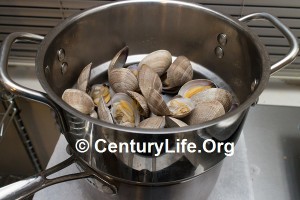 If there’s ever any doubt, just steam longer. Over-steaming usually doesn’t hurt food, though it’s possible to overcook, say, shrimp and clams so that they shrivel up and become less tasty. But many foods tolerate a little over-steaming.
If there’s ever any doubt, just steam longer. Over-steaming usually doesn’t hurt food, though it’s possible to overcook, say, shrimp and clams so that they shrivel up and become less tasty. But many foods tolerate a little over-steaming.
As you gain experience, you will gain a better feel for how long things take to cook, and you might find that you don’t need to measure temperatures as much or even at all anymore.
Happy steaming!
